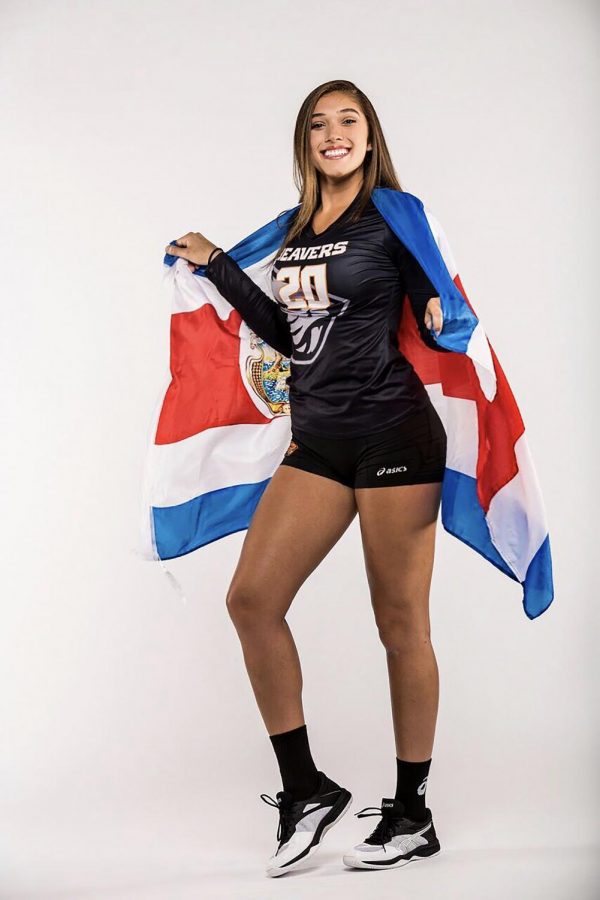Playing away from home
January 7, 2019
International student-athletes at Oregon State University face a unique set of challenges when they arrive on campus.
Student-athletes must succeed both physically as an NCAA Division One athlete and academically as a university student. In addition to that, they are studying in a foreign country and could possibly be experiencing the effects of culture shock. Regardless of where they are from, international student-athletes experience the same forms of stress and frustration universally.
Daniela Vargas, a fourth-year on the women’s volleyball team, has experienced plenty of frustration with living in a foreign country. Trained as a dancer, Vargas only became interested in volleyball after her father, a former National volleyball captain, introduced her to his teammates.
Vargas was a member of the Costa Rican National Team, but wanted to further her education in the United States. She took the initiative to reach out to American coaches and joined OSU’s volleyball team four years ago. Since then, she has developed a close group of friends whom she says are like her family here.
According to the NCAA, student-athletes must maintain a GPA of 2.3, which for Vargas was a new concept.
“Back home (in Costa Rica), you pass and you pass.” Vargas said. “There is no GPA back home. That doesn’t exist…You pass the class, you get an eighty-five… Here, it’s a B, and you’re lowering the team average… Staying on track with all of my assignments and trying to get them in on time, I’d say has been the most challenging.”
Vargas’ OSU family helps her handle the annoyance of balancing everything, as well as provides her with a buffer against homesickness.
“Homesick never goes away,” Vargas said. “(I’ve been) homesick for four years. Never goes away.”
Similarly, Rachel Walters from Jamaica and Kate Evans from England, both on the women’s soccer team, experienced varying forms of homesickness, whether it was due to the drastic change in weather and food or the difference in team members. However, just as with Vargas, they too found a second home with their teammates.
Another issue that can affect an international student-athlete’s experience is the possibility of injury. For students who are attending on an athletic scholarship, an injury could affect their ability to continue their education. According to the NCAA, athletic scholarships can be withdrawn due to underperformance or injury.
Sebastian Briski, a first-year football player from American Samoa, is recovering from injuries that occurred earlier this year. Due to the nature of his injuries, Briski has been unable to practice with the team.
“Being a first-year, I’m trying to make a good impression on the team,” Briski said. “And not being able to show them what I can do has been stressful.”
Common concerns among the international student-athlete community include the language and cultural differences between their home country and the U.S. Paula Diaz Leblic from Spain and Loke Strenov from Denmark, both OSU soccer players, found that dealing with American culture has been the most trying experience for them. Diaz Leblic finds writing her assignments in English to be the most time-consuming task.
According to Diaz Leblic, when dealing with writing assignments, what would take an American student around thirty minutes to write, takes her much longer. Strenov, on the other hand, found expressing himself in English to be the biggest challenge.
“The culture and how you grew up is also a little bit different,” Loke said via email, “so you don’t really understand the American humor in the start…”
Even students from Canada experience these concerns. Kory Cheshire, a fifth-year on the women’s volleyball team, is the first person in her family to attend college. Though her home is closer than others’, she still misses Canada at times.
According to her, in Canada, the Winter Olympics is a huge deal and is covered practically everywhere. In the U.S., that is not so much the case. For Cheshire, coming to the U.S. was more of a struggle in the sense that she had no idea what to expect. Since neither of her parents went to college, Cheshire had to depend on learning as she went along. In addition, she needed to work with the strict regulations set by both the International Services and the National Collegiate Athletic Association.
“There’s a lot of stuff, rules and regulations, I don’t think people realize we, as international student-athletes … have to comply to,” Cheshire said. “For example, we always have to have nine credits (physically) on campus…I need to make sure all these credits are going toward something so that I can be eligible to play. Not only do I have to comply to stay in the country, I have to comply with the NCAA.”
According to Cheshire, one of the most difficult tasks she is currently facing is having to register for at least six on-campus credits to stay in the country. The only classes that are offered, however, that can go towards her major are online. She says she doesn’t want to register for classes that might cost the athletics money or that won’t help her in her studies.
While being an international student-athlete has its hurdles, with the help of teammates, friends and family, these individuals are learning how to navigate a new country and play the sport they love.
























































































































